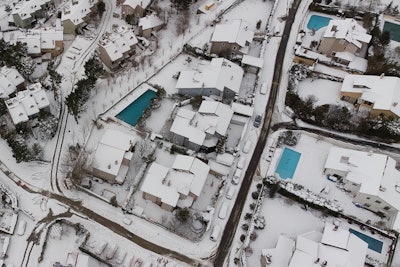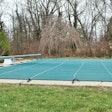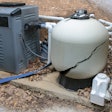
Although summer feels like it just kicked off in many areas of the country, the sad truth is that winter will be here before we know it.
Along with winter comes gray skies, cooler temperatures and closed pools — and a time of disappointment for many as the summer days of splashing, sunshine and hours making memories by the pool comes to an end.
Luckily, winter won’t last forever, and spring will come back around soon enough.
Before that happens, it’s important to understand why strategic steps when closing your customers’ swimming pools can be the key to opening a clean pool come spring. After all, a good closing plan is the secret behind an easy spring opening!
Shutting Down
The goal of closing a pool in the off season is to protect the pool equipment and surfaces, while also (hopefully) maintaining clear water upon opening.
To accomplish this goal, proactive measures must be taken to limit bacteria and algae growth in the off season. Water must be balanced prior to closing the system to protect the pool surface and equipment. These are the must-do elements to a complete winterizing program for pool care.
Keep in mind the two methods of cold water pool care: off-season care and winterization. Determining which approach is appropriate is dependent upon the anticipated weather during the winter months — but, ultimately, timing is the key to success regardless of the winterization procedure.
Do not close the pool too early. In many cases, especially in commercial pools, the pools are opened and closed by the calendar. For example, many customers open their pool around the first of May or later, and close it at Labor Day — regardless of the current weather conditions. This leads to problems keeping the pool protected during the winter and makes it more difficult when you go to open in the spring. Cooler water while the pool is closed is imperative for a successful spring opening.
Calendar Close?!
When one chooses to open and close by the calendar, water is often already warm when opening the pool and still warm when closing the pool. And, as we know, warm water is a more ideal condition for bacterial growth and algae blooms.
Winterizing chemicals applied to warm water will not be as efficient in the off season or as effective at keeping the pool clean and clear. Chemicals added to warmer temperatures are used up at a faster rate because they have more work to do in warm water.
Pools that are closed while warmer or opened after the water has gotten warm or even hot are much more likely to be cloudy, green and demand larger amounts of chlorine. A tip for success is that pools should ideally not be closed if the water temperature is above 70 degrees Fahrenheit and should be opened again before water reaches 70 degrees Fahrenheit in the spring.
Off-season pool care is required for climates where weather doesn’t stay cold for very long in the winter months. In these locations, water temperatures stay above 70 degrees Fahrenheit for a longer period of time in the fall and warm up faster in the spring.
Water will cool down through the off season, but often warms back up quickly due to a shorter and more mild winter season. While this is great for people who hate winter, it can be difficult to keep a pool clear and protected under these inconsistent or unpredictable circumstances. Because bacteria and algae reproduce more rapidly in warm water, winter chemicals will be depleted more quickly and a mid off-season check is recommended to ensure the pool water remains balanced.
At “opening” or really pool season kickoff, a pool that has been unprotected for an extended period can be difficult to clear and get ready for swimming. Pools that are kept open in more mild climates should run the circulation system at least daily to keep the water moving and check water balance to protect the pool surface and equipment.
While weekly pool care is often suspended during these periods, the water should be sanitized and shocked periodically over the course of the off season. Also, additional algae treatment is often necessary to help keep the pool clear due to the lower frequency of the pump and filter system being run.
Frigid Temperatures
An important point to make here is to keep an eye on these types of pools if the temperature drops much lower than usual, to the point where freezing is a concern. If there’s a potential for a freeze, running the pool pump continuously to help prevent frozen pipes is critically important. Unfortunately, many pool owners learned this the hard way in the Texas freeze a couple years ago.
Winterization is for climates where water gets cold and stays cold. There is risk of freezing, and equipment is unhooked and protected to prevent it from damage that can occur in winter conditions. Algae and bacteria are less likely to grow and reproduce in water this cold, and winterizing chemicals tend to last longer.
Pools that are winterized do not continue to run while closed. Chemicals are added at closing, then the water is drained down below the skimmer and equipment is drained, plugged, and sometimes even removed to protect it from freezing and from potential damage throughout the winter. In many cases, pools are not treated again until spring opening. However, if the winter is unseasonably warm or the pool was closed too early, a mid-winter treatment of algaecide may be necessary to help keep the pool clear.
Put a Lid on It
Regardless of climate, covering the pool is an important part of off-season pool care. The pool will go long periods of time without use, and most pool owners stop paying attention to maintenance activities, such as brushing, skimming and vacuuming, in the off season. Pools are not top of mind when no one wants to swim after a hot day!
Dirt and debris will be introduced over the course of the winter months and covering the pool will reduce the need for these pool maintenance activities. As winter progresses, pool owners should keep excess water and debris cleaned off the top of the cover. If water and debris get too heavy, the cover can be pulled into the pool. This can damage the pool or cover itself, as well as create a big mess to clean up when the debris from the cover ends up in the pool, too.
In the spring, when you remove the winter cover, take care not to allow dirt, debris and contaminants from the top of the cover fall into the pool. This can create problems with filtration, water clarity and chlorine demand, as well as other issues.
Chemical Essentials
The main winter products used for closing include shocking the pool, adding a preventative algaecide, and using a stain and scale product to protect the pool surface and equipment. When chemically winterizing a pool, it is imperative to treat and remove all existing problems before closing. Closing a pool with issues will allow problems to get worse over the course of the winter, causing additional requirements of time and chemicals during spring opening. Water balance, sanitizer residual, and water clarity should all be evaluated and balanced before a pool is closed. Clearing up problems before closing allows the winterizing program to work effectively, and helps you open the pool more quickly and with less elbow grease required in the spring.
To ensure surface protection and chemical efficiency, pH, total alkalinity, and calcium hardness should all be balanced to ideal parameters before the pool is closed. Winter temperatures bring colder water, which can lead to a corrosive environment. Prolonged exposure of corrosive water to the pool’s surfaces may cause etching and metal staining to become more prominent on pool surfaces, as well as cause increased potential for damage to pool equipment. In addition to balancing the pool water before closing, a stain and scale control product should be added at closing to protect the pool from surface problems and metal-based staining or water discoloration. These products are a great combination to provide superior protection over the course of the winter, setting you up to get the pool started off in the right way when summer rolls around again.
Additional products that can help make winterizing more effective and ensure a smooth spring opening include enzymes and phosphate removers. Enzymes, paired with surfactants, will break down non-living contaminants in the water, reducing the workload for chlorine. Not only is the pool easier to open, but that ugly scum line accumulation that often mars spring openings will often not form when enzymes are present through the off season. Reducing and minimizing the level of phosphate in the pool upon closing is also a key action to take to help ensure a faster turnaround time at opening. The addition of a multi-functional product that contains both enzymes and a phosphate remover can be a key element in helping to prevent problems over the course of the winter.
Being thoughtful and taking proactive measures at winterization will lead to a faster and easy spring opening experience. Following the steps discussed can help ensure you’ll open pools that are clear and ready for swimming in no time!
Recap — Tips to Remember:
- Don’t close by the calendar! Close when the water temperature is consistently below 70 degrees Fahrenheit, and open before the temperature is consistently 70 degrees or higher.
- Choose the correct method of off-season pool care for your area (determine whether to fully close pools or if off-season attention will suffice).
- Cover the pool, regardless of whether it’s fully shut down or not.
- Don’t close a pool with any water clarity or chemistry problems present.
- Water balance is key!
When you close the right way, you can rest easy knowing that spring openings will be easier than ever before! But for now, relax and enjoy some off-season downtime — you’ve earned it!
Alicia Stephens is the director of education and training manager for Biolab, Inc. She focuses primarily on education, training and development, as well as technical support and new product research and integration. She can be reached via email at [email protected].
This article first appeared in the September 2023 issue of AQUA Magazine — the top resource for retailers, builders and service pros in the pool and spa industry. Subscriptions to the print magazine are free to all industry professionals. Click here to subscribe.
































